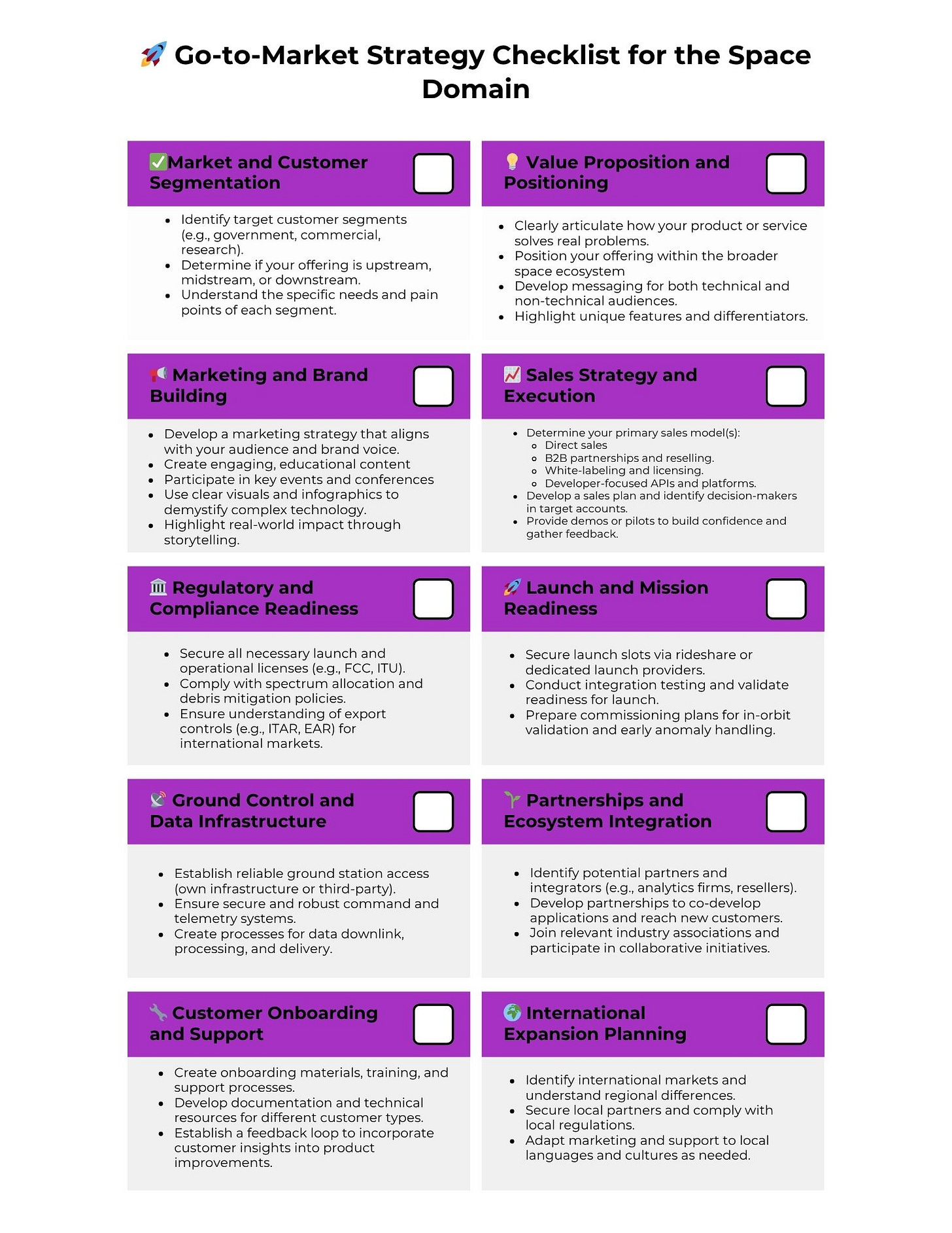Go to Market Strategies for the Space Domain
What your space company needs to know before introducing a new product to the space market
I have been writing a lot about digital marketing and website strategies as it relates to the space industry. But in today’s newsletter I want to take a step back. Because businesses do not just build websites for the sake of having a website. Websites come in as a tool to help achieve business goals. The business idea, the solution to the problem, comes before any website can be planned.
Before any website can be created, planned and strategized, the marketing function needs to consider a well-planned go-to-market strategy.
A go-to-market (GTM) strategy is the plan your space company uses to successfully introduce your product or service to the market, engage the right customers, and achieve product/service adoption and revenue goals. This means aligning your unique technology, whether it’s a satellite, launch service, or data analytics platform, with the specific needs of your target customers, while navigating the complexities of regulatory requirements, international markets, and the broader space ecosystem.
In today’s newsletter, I want to explore strategies and requirements that help space companies, from satellite operators to data analytics firms, go to market with their innovative offerings. The space sector depends a lot on local governments and politics making the go-to-market process complex and intricate. Strategies and processes of introducing a new product often involve more than just standard marketing practices and brand positioning. For clarity, I have tried to give examples below and am also giving you a downloadable checklist.
Defining the Go-to-market Requirements within the Space Domain
Here’s a breakdown of what GTM requirements typically include in the context of the Space domain:
1. Market Identification and Segmentation
Who is the target customer?
Government agencies (e.g., NASA, ESA, DoD)
Commercial operators (e.g., SpaceX, Planet, Amazon Kuiper)
Research institutions or universities
End-users of space data (e.g., agriculture, maritime, finance, telecom)
What segment are you addressing?
Upstream - This covers the design, manufacturing, and launch of spacecraft and satellites, essentially, building and sending hardware to space.
Midstream - This involves the operations and maintenance of assets in space, keeping satellites running and making sure data is collected and transmitted properly.
Downstream - This covers using the data or services enabled by space assets, applying the information collected from satellites and turning it into usable insights or products.
2. Value Proposition and Differentiation
What unique problem does your solution solve
Identify the problem you’re solving
How is it better, faster, cheaper, or more reliable than alternatives?
Why should prospects choose you?
For space companies, this could be:
Faster access to orbit
More frequent Earth imagery
Lower latency communications
In-orbit servicing to extend satellite lifespan
3. Sales Strategy
A key part of your go-to-market plan is how you actually sell your product or service—especially in the space sector, where the sales cycle can be long and complex, and the buyers are often specialized. Here are some common approaches:
Direct government contracting (e.g., NASA SBIR)
Selling directly to government agencies—like NASA, ESA, DoD, or national space agencies—which are often the largest and most reliable customers in the space industry.
B2B partnerships (e.g., reselling Earth observation data)
Collaborating with other businesses in the space value chain to integrate your product or service and reach end-users together.
White-labeling your tech to integrators or operators?
Offering your technology or platform to other companies so they can rebrand or integrate it into their own services, often in ways that end-users never see directly.
4. Marketing and Positioning
In the competitive and rapidly evolving space industry, how you position your brand and communicate your value is just as important as what you’re offering. Effective marketing and positioning not only build awareness but also attract the right partners, customers, and investors.
Positioning within the broader space sector (e.g., “NewSpace,” sustainability, defense)
Positioning is about how your brand and product stand out from the competition and fit into the larger industry narrative. In the space sector, it’s essential to define which part of the ecosystem you’re aligned with and what unique angle you bring.
Participation in key events (e.g., Space Symposium, IAC)
The space industry has a plethora of trade shows, conferences, and summits that are essential for networking, visibility, and thought leadership.
Participating in these events can: 1. build brand recognition among decision-makers and potential customers; 2. Provide speaking opportunities to showcase expertise and thought leadership; 3. Generate media coverage and buzz around your product or service.
Clear messaging for technical and non-technical audiences
Your messaging must resonate with engineers, scientists, and mission operators, who care about technical specs, and also business decision-makers and the public, who care about impact, value, and broader relevance.
5. Market Competition
In the space industry, understanding the competitive landscape is a crucial part of any go-to-market strategy. While it can be tempting to focus only on your own innovations, it’s important to analyze how existing products and services meet customer needs—and how your solution compares. This includes identifying direct competitors (e.g., other satellite data providers) as well as indirect ones (e.g., drone-based imaging or alternative analytics platforms). By benchmarking your technology, pricing, and user experience against these competitors, you can refine your messaging, differentiate your value proposition, and identify gaps or opportunities in the market. Ultimately, knowing what else is out there isn’t just about staying ahead—it’s about making sure you’re delivering the most relevant and compelling value to your customers.
6. Other
Regulatory and Licensing Requirements - Space is highly regulated. Your go-to-market plans must address:
Launch licenses
Spectrum allocation
Export controls
Debris mitigation and compliance with international treaties
Partnerships and Ecosystem Access - Space companies often rely on complex ecosystems:
Launch providers
Ground station networks
Satellite integrators
Data resellers or analytics partners
A go-to-market plan might include signing contracts, joining consortiums, or securing distribution channels.
Funding and Risk Mitigation - GTM in space is capital-intensive.
Do you have the funding to reach key milestones?
Can you mitigate risk (e.g., failed launches, delays)?
Example:
A startup building hyperspectral imaging satellites might have these GTM requirements:
Regulatory approvals, Launch readiness, Ground infrastructure:
Secure launch licenses and permissions to transmit data from national and international regulators.
Ensure spectrum allocation and debris mitigation compliance.
Find affordable and reliable launch slots, typically via rideshare programs with providers like SpaceX or Rocket Lab.
Establish ground station networks (own infrastructure or through third-party providers) to downlink and process large volumes of imagery data.
Industry partnerships:
Partner with agricultural companies or other downstream users to test and integrate the data into real-world applications.
Validate use cases like precision crop health monitoring or soil analysis.
Tailored value propositions:
Create messaging and business models that resonate with different customer segments, such as:
Government users focused on environmental monitoring, national security, or disaster response.
Commercial customers looking for competitive advantages or operational efficiencies.
Marketing and brand positioning:
Develop a compelling story around how hyperspectral imaging solves critical challenges, positioning the startup as a leader in the emerging “NewSpace” ecosystem.
Create engaging content (whitepapers, blog posts, videos) to showcase applications and build credibility.
Identify and participate in key events (e.g., Space Symposium, IAC, industry-specific conferences) to network, share results, and attract partners.
Build trust through clear, user-friendly explanations of complex technology (e.g., infographics, simplified data examples).
Lead generation and customer education:
Offer demos or trials for prospective customers to experience the data and insights.
Develop a website and collateral that highlight practical use cases and real-world impact.
Provide onboarding and educational resources to help new customers integrate the data into their existing workflows.
Different Go-to-market Strategies in the Space Sector
A robust go-to-market (GTM) strategy in the space sector can take several forms, each tailored to different customer bases, products, and missions.
Direct sales to government agencies—like NASA, ESA, or defense organizations—are common for companies providing launch services, hardware, or data, relying on competitive bidding, RFPs, and strict compliance with procurement standards.
B2B partnerships and reseller agreements are crucial for companies offering data or components that other commercial operators need, helping expand reach and integrate seamlessly into broader ecosystems.
White-labeling and technology licensing provide a way for space companies to scale by letting others rebrand or integrate their technology, while still maintaining control over core capabilities.
Another key GTM approach is vertical market focus, where companies develop tailored messaging and features for specific industries—such as agriculture, insurance, or maritime—who use space-derived data for real-world insights.
Finally, companies can engage developers and integrators by offering APIs, developer toolkits, and robust documentation, fostering innovation around their core technology and enabling entirely new downstream applications.
Each GTM approach has unique challenges and advantages, but they all share the same goal: ensuring that groundbreaking space technology doesn’t just launch—it finds sustainable market traction.
Example:
A strong example of this is Planet Labs, a company that operates one of the largest fleets of Earth observation satellites. Their GTM strategy includes:
Vertical focus: Developing tailored imagery and data analysis for sectors like agriculture, forestry, insurance, and climate monitoring.
User-friendly tools: Providing an easy-to-use online platform that lets customers browse, analyze, and integrate satellite data.
Partnerships: Collaborating with data resellers, analytics firms, and research institutions to expand reach and usage.
By aligning their offering to specific customer pain points in these verticals, Planet Labs has successfully positioned itself as a go-to source for actionable Earth observation data.
Types of Go-to-market Strategies
In the space domain, go-to-market strategies can be shaped by different operating models that define how you engage customers and drive adoption.
A sales-led approach is common in traditional government or defense contracting, where relationships and long sales cycles require skilled sales teams to navigate procurement processes and build trust.
In contrast, a product-led approach—more typical in the commercial and downstream space sector—relies on self-serve demos, freemium trials, and intuitive interfaces to let customers experience the value of your data or platform directly.
Some companies adopt a marketing-led model, investing heavily in brand building and thought leadership to generate demand in a crowded and competitive market.
Finally, a partner-led GTM approach leverages strategic alliances and integrators to expand reach and access customers that might be otherwise difficult to engage directly.
For space companies, combining these approaches, tailored to the target customer and product complexity, can be key to capturing opportunities in both established and emerging market segments.
Final thoughts
The go-to-market strategy is part of a bigger marketing planning. It doesn’t have to be perfect but to put it in simple words, having the strategy and plan in place ensures that you know what you are doing. You are not just going in blind but you have a clear picture of what to expect, how to approach this complex industry that yet is in its infancy and is facing a lot of problems that need to be solved.
Thanks again for being here!
Keep reaching for the stars!
Stela, StellarStrategy





